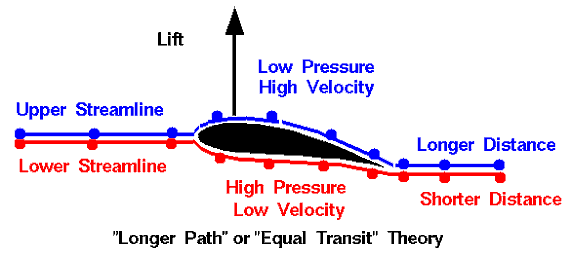aerodynamic
aerofoil
aeronautical
aeroplane
Air
air flow
aircraft
aircraftnerds
aircrafts
Bernoulli's principle
incorrect
lift
theory
Ventuimeter
How do wings generate lift?
Lift theory
Lift on an aerofoil is due to the presence of pressure difference between above and below the aerofoil. According to Bernoulli's principle, this pressure difference is a result of the difference in the velocity of airflow above & below the aerofoil. But most of the people are having a misconception about what is a cause of velocity differences above and below the aerofoil.
Incorrect Lift Theory: - Aerofoils are shaped in a such a way that upper surface is more curved than the lower surface. So that air flowing above the aerofoil has to travel a longer distance than air flowing below the aerofoil. And both airflow has to meet at the same point at the end of an aerofoil. This is a reason why air flowing above aerofoil has the higher velocity than air flowing below aerofoil.
But this theory mentioned above is wrong.
There are many of issues in this theory. According to this theory, aerofoil is designed in such a way that air flows longer distance above the aerofoil than air flowing below the aerofoil. But in a case of a symmetrical aerofoil, air flow above & below the aerofoil travels same distance even though symmetrical aerofoil provides sufficient amount of lift at some angle of attack. Airflow above & below the aerofoil does not meet at a single point of the trailing edge of an aerofoil. According to NASA air flowing above aerofoil is so fast that it passes the end of aerofoil before air flow below aerofoil.
So what is the reason of velocity difference above & below aerofoil
 |
| Venturi - Wikimedia |
There are mainly two types of pressure, one is static pressure and other is dynamic pressure. Dynamic pressure will be the pressure on the flat plate held in front of the flow. While static pressure is a pressure on the walls of the tube. While talking about Bernoulli's principle, we are talking about static pressure. It means pressure acting on the walls of the tube through which fluid is flowing.
Bernoulli's principle states that larger the cross section area, lower the velocity of flow. And hence high pressure at the larger section.
Physical meaning of Bernoulli's principle
As the area of cross section is reduced, the velocity of flow at that cross section will increase. This is due to conservation of mass. Consider a flow in a tube with the varying cross section area. The mass flow rate through a bigger cross section will be equal to the mass flow rate through a smaller cross section area. So to conserve mass flow rate, the velocity of flow increases while flowing from bigger cross section area to smaller cross section area. This condition can be given in terms of continuity equation for constant density,
A1 * V1=A2 * V2
A1, V1 = Area, Velocity at bigger cross section
A2, V2 = Area, Velocity at smaller cross section
Now, this was about the increase in velocity with reducing cross section. Now about pressure, This can be explained simply by conservation of energy. When cross section area of the tube is reduced, the velocity at that cross section will increase, it means kinetic energy at that section will increase. So to conserve total energy, pressure energy at that section will reduce. And hence, static pressure at that cross section will reduce.
Application on an aerofoil
Now Consider any unsymmetrical aerofoil. If you consider an aerofoil in XY plane, you will notice that upper curve of the aerofoil will be increased in Y axis initially with respect to the X axis from the leading edge. And the then same upper curve will meet X axis at the trailing edge. And lower curve will be a straight line. If you take a look at the upper curve of the aerofoil, it forms semi venturi shape with the far away undisturbed air flow which is just above the upper curve. And now applying Bernoulli's principle on this semi venturi. The region where the upper curve of the aerofoil is at the highest point in the x axis will form an area of the lower cross section (and hence higher velocity) with the far away undisturbed flow which is present just above the upper curve of an aerofoil. And thus the speed of the airflow is higher above the aerofoil as compared to the speed of the airflow below the aerofoil. Which results in pressure difference above and below the aerofoil. This unbalanced pressure force results in the production of the lift.Lift explanation based on Newton's third law
Again, Consider any unsymmetrical aerofoil, assume that air flowing above aerofoil is going straight without any deflection with respect to aerofoil curve. But as the upper surface of the aerofoil is curved, the low-pressure region will be created in between aerofoil and airflow. This low-pressure region will suck the airflow and airflow will follow the curve of an aerofoil. This effect in which airflow attaches to the nearest surface is known as Coanda effect. Now according to Newton's third law, every action has an equal and opposite reaction. So, reaction to the force which bends the air flow is the lift force. So, this was an explanation for the production of lift based on Newton's third law.
That's why lift is known as reaction force!!!!
Now you know the correct concept of lift. Ask your teachers or friends about the lift to the aerofoil, if they are giving the same wrong explanation then clear their doubt & become hero!!!






